#unlike* in pathfinder
Text

the idea of the demon's canon name just being demon is really funny
#maplestory#“yeah he's a (half) demon. his name is demon”#i wonder why they went with not giving demon a canon name unlike the heroes etc.#i feel like if he was released nowadays he would be named and that would be his class name like all the new classes since cadena#well. except for pathfinder lol#i remember seeing when digging through old maple fandom stuff from like the early 2010s that people used valfor for the demon's name#where did that come from? was that just something someone suggested and everyone ran with it#was it in an event? the namu wiki article mentions the female demon showed up in maplestory live with the name elijah?#it was possibly something else but the google translate says elijah which is. certainly a name for a female demon#anyway why did people use the name valfor? i was especially confused since there's already a monster called valefor#i think the explorer thief questline to fight valefor is gone now but it was there.#very confused as to why people used a name that was very close to a preexisting monster. i know they're referencing the same thing but...
5 notes
·
View notes
Text
Early Rogue Trader spoilers! (I'm about to start act 2 but this was from before)
Just as I was starting to grow bored of this game, a cursed piece of broken sword appeared and started promising me godhood. I am now waiting patiently for the dire consequences to come xx




#Blighted Posts#Rogue Trader spoilers#OC: Azra#I think my boredom was solely coming from knowing fuck all abt the setting unlike Pathfinder which I've played the ttrpg of before#Too many big unknown words and my monkey brain goes zzzzmimimimi
8 notes
·
View notes
Text
Adramelek found the necronomacon and gave it to his vampire crush, learned about the Shadow Druids and found a convenient excuse to kill Kaga’s child murdering ass, and poisoned the goblins’ ale to kill off like half of them in one go.
I promise I’m really not planning to play as much of an asshole as Calio a second time 😂 He’s just going to slowly redeem himself as the story goes. The seeds are being planted in act 1 and will pay off in act 2, the big change eventually being of course refusing to kill Isobel and facing the consequences.
#bg3#bg3 spoilers#my durge#Addy likes using intimidate for all of the things#unlike Calio who did a pretty even mix of deception and persuasion for everything#everyone trusted Calio so much because he was such a good liar/just silver tongues in general#and then he betrayed them all because he *actually* became an evil asshole this time around#(I like in pathfinder where I expected him to go down a slippery slope of evil choices but instead the power of love and friendship#kept him firmly in chaotic neutral territory…whether he likes it or not 😂)#unlike* in pathfinder
2 notes
·
View notes
Note
You said that yog sothoth has witnessed all of the previous multiverse cycles and probably the any others. So do that basically make him the capital G god of the pathfinder multiverse?
He is indeed the Overgod of the Great Beyond, inasmuch as he is the most powerful entity in the setting. His shadow alone is CR 30 and cannot actually be defeated. There are gods of time, but then there is Yog-Sothoth, who IS time.
The Watcher is a far cry from, say, Ao from the D&D universe; he does not create or destroy gods, takes very little role in creation itself, nor does he directly interfere with anything unless invited to do by mortalkind. He is a purely passive presence, reacting only if interacted with, that one could reasonably assume isn't even sapient in an understandable way. As his title suggests, he merely watches and, on occasion, aids the Survivor in some strange, alien way when it's their turn to begin the next cycle.
#Asks#Anonymous#Pathfinder#And unlike Ao there are no hints that it works for a higher presence#As far as anyone knows Yog is the highest presence there is
9 notes
·
View notes
Text
listening to the me:a ost for work and tbh it is incredible how much me:a is an improvement on the 'bioware open world game' formula. like i still think its weaker but in comparison to da:i, me:a is infinitely more playable and feels more full of an actual soul.
Like. I have 100%-ed both games. I will NEVER 100% da:i again, and honestly im not sure if i would even *play* it again. meanwhile i, 1000%, would replay me:a, and i could even see myself doing everything in it again. The grind isnt unbearable, gives you time to hear other party convos, and lots of the sidequests have memorable characters and concepts
#Shitpost#dai is such a dead soulless game that playing it feels like inviting weeds to grow inside me#so much in that game ends in a body and just stupid text#Its. Really really terrible on a world gameplay aspect#Such a just. Personally harmful game to me really just because its so cynically devoid#A good microcosm is how like every quest in dai leads to really nothing of consequence vs#In mea one of the most interesting and personal story moments is tied *into* the gameplay#The random exploring of points unlocks your fathers memory#which is something so personal and it also makes sense since you literally took his place and like#Literally are becoming an expert at what he was an expert in etc#and you unlock the MOST MEANINGFUL MEMORIES possible and theyre ALL rewarding#actual CUTSCENES of the family and of SAM too#and you learn so much#mea has some intrigue that was meant to lead to a sequel that seems like itll never come#Its so annoying because mea was hated and flamed for arbitrary incorrect reasons#fucking gamerbros i hate you#Anyways. The intrigue in mea wasnt the only interesting things that happened unlike dai#they were interesting little snippets but the true core was already there#Finding the other pathfinders is a good exame of meaningful choices offered. Alongside the dad focused quests i mentioned earlier#just idk parts of mea were a little too grindy and so theres some of the threadbare irritation#but it has so much more than dai did
2 notes
·
View notes
Text
Haven't been reading any books cause I've kind of dived back into playing the Wrath of the Righteous CRPG now that it's pretty much as complete as it will be (unless there's some big dlc coming I'm unaware of). God it's really making me want to gather up a group and run some actual Pathfinder games though.
Still feel like I'm too tired after being a foreverGM for nearly 7 years, but that 3 action economy will forever be calling my name. At least I can have fun pretending to be a demon slayer in my computer game while I gather up the energy to do anything GM related
#also really wish getting people to run their own games wasnt like pulling teeth#at least pathfinder is fun to run unlike another fantasy rpg#pf wotr#pathfinder
0 notes
Text
haven't seen this on here yet so:
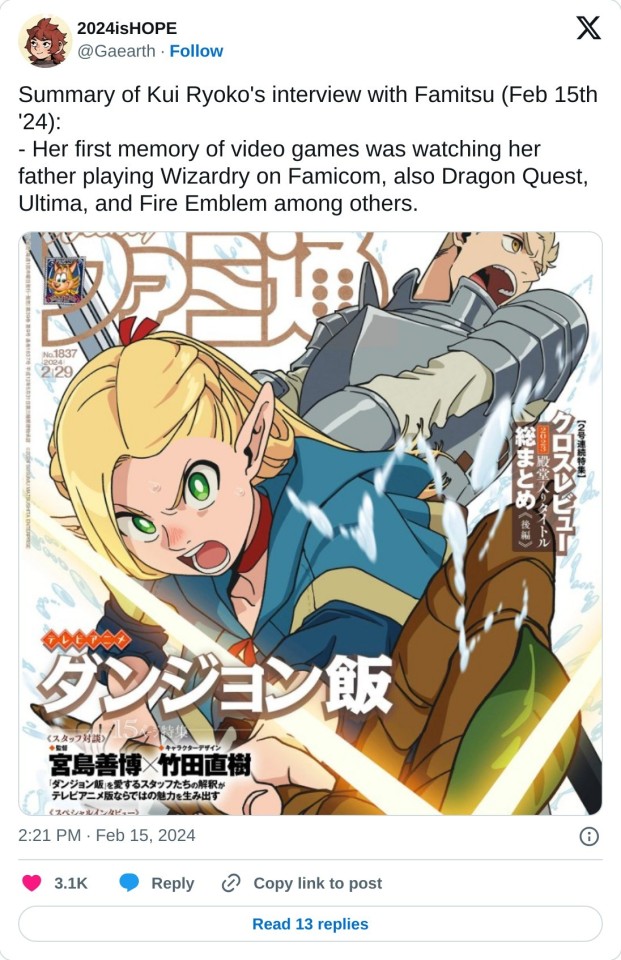
in case you don't want to slog through the shitscape that is the bird/letter website, take a peek beneath the cut (shamelessly copied from the something awful forums dungeon meshi thread)
- Her first memory of video games was watching her father playing Wizardry on Famicom, also Dragon Quest, Ultima, and Fire Emblem among others.
- She was a difficult child so her parents didn't let her play. Wizardry is a boring game to watch, but the monster illustrations on the walkthrough evoked her imagination and made her keep watching.
- She only started becoming a serious gamer after the serialization of Dungeon Meshi was locked, for research purposes. Before that, she read fantasy novels such as The Neverending Story (Michael Ende) and The Lord of the Rings (JRR Tolkien).
- The international title for Dungeon Meshi: Delicious in Dungeons was decided by her editor.
- D&D popped up a lot when she researched the history of video games, so she read the rule books, replay novels, and games inspired by D&D.
- One of the first games she studied was the Legend of Grimrock (game's 80% off on Steam atm). Originally, she wanted Dungeon Master (FTL Games) which was famous for "RPG with meals" but hunting down the game and machine was too much.
- She didn't like games other than turn-based RPGs at first, but she decided to stop being picky and play anything that piqued her interest.
- She played Zelda: BotW and TotK on a borrowed Switch from her editor due to the console's scarcity at the time.
- She enjoyed Red Dead Redemption 2 and God of War for their stories. RDR2's incredible attention to detail had Kui engrossed so much that she asked her editor and other mangaka to play it so she could discuss it with them.
- Kui praised The Witcher 3 localization as something only possible with full support from the developer. Cyberpunk 2077 is one of her all-time favorites.
- Papers, Please was her first taste of indie games.
- Disco Elysium is the perfect game for her due to the lack of fighting, intriguing story, charming character interaction, and top-down perspective. She tried playing it in English at first due to an unlikely chance for JP loc, but it was out of her ability. Thus she is forever grateful to Spike Chunsoft for localizing it.
- Kui played Baldur's Gate 3 from the time it was in Early Access. Again, she's grateful for Spike Chunsoft's JP loc. She hoped BG3's success would bring the possibility of JP loc for other titles too, such as Pathfinder: wotr
- She likes games with top-down perspective because they have narration text for monologues and scenery description. Even if the graphic is lacking, the texts show the atmosphere and each character's behavior and psyche. Also, characters that react to your choices.
- She praised Unpacking and House Flipper for being able to tell what kind of person lives there only through their belongings, and that there's no right or wrong for the placements; she would make the best arrangement and then enjoy her hard work while sipping tea.
- The biggest inspiration for Dungeon Meshi was the Cosmic Forge pen from Wizardry VI. With improved graphics from its predecessor, now it could show broken farming tools in the background and many more details that made exploration so much fun.
- At the time of the interview (Dec '23) she still hadn't watched DunMeshi anime, but she attended the recording sessions. She's embarrassed that the dialog she wrote now acted passionately by professionals. Marcille's screaming was wonderful but also made her want to flee.
- Kui was anxious about the CP2077 anime adaptation, but she was relieved it was the Night City she knows and loves.
- Other than minor adjustments, she left it to TRIGGER as to how to adapt
- She's happy that Mitsuda Yasunori was chosen as the anime composer, as she used to play Chrono Cross and rewatched the opening many times.
- Her anticipated games in 2024 are Cloudpunk, Nivalis, and Avowed.
- DunMeshi would be hard to adapt into a game because in the first place, what Kui depicted in the manga are parts that are omitted in games for the sake of brevity.
- If DunMeshi game was Wizardry-like, it'd be told through Laios' perspective and eating was essential not to die
#dungeon meshi#she only started playing video games after dunmeshi got picked up???? damn#that's dedication to the craft#i would *so* play a dunmeshi video game...#likes top-down perspective and strong narratives and character reactivity... she's just like me fr
7K notes
·
View notes
Text
Earlier today, Paizo announced long awaited books for their Asian inspired continent Tian Xia. Unlike many other companies attempting projects that large, Paizo went out of their way to hire damn near every Asian TTRPG writer in the business.
 I’ve worked on ~100 books & games. I’m often the only Asian on a project. It’s rare to have more than 1 other Asian on a book with me.
The Tian Xia books?
There were like 40 of us! 😲
I’m really glad that Paizo took the time to do this right. 💚
Players are going to see what a difference that level of representation makes when they get their hands on Tian Xia & see the massive diversity of Asian cultures & experiences reflected in the books.
I’m not just talking about countries or ethnicities; there’s also different stories of identity — diasporic groups, immigrant experiences, people reconnecting with their heritage, refugees, people finding & making places of belonging, … The sheer breadth of Asian experiences and identities represented in Pathfinder’s Tian Xia team and in our books is astounding. 
This is why representation matters.


#pathfinder#pathfinder 2nd edition#pathfinder 2e#tian xia#ttrpg#paizo publishing#paizo#asian representation#representation matters#asians represent#roleplaying games#lost omens
2K notes
·
View notes
Text
VIVERE
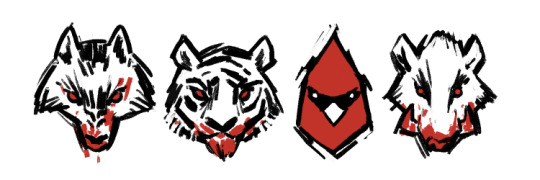
“Do you think you deserve it? To be punished?”
“I think so, yes.”
A Pathfinder 2e Campaign Introduction Post!

MEET THE PARTY:
REVUN (@dovelydraws)
26 years old
he/they/she
A duel-wielding tiefling fighter. Easy-going freelance mercenary from Alephia, looking for a job that pays well and a little company.
FERRA (@artpepkin)
87 years old
she/her
A beastkin elven rogue from Chiei Thya. Playful vagabond who finds herself wherever the wind takes her. She's maybe gotten herself in a little over her head.
POLITES (@mossy-garden)
17 years old
he/him
A tiefling champion. Proud kingdom guard of Crimyria under the goddess Vildeas, who is willing and anxious to prove himself.
KWAN (@jinbugs)
39 years old
he/they/she
A human investigator. Cunning Po Lian scholar-official informant who is in pursuit of a dangerous secret, the centurion pearl. At any cost.
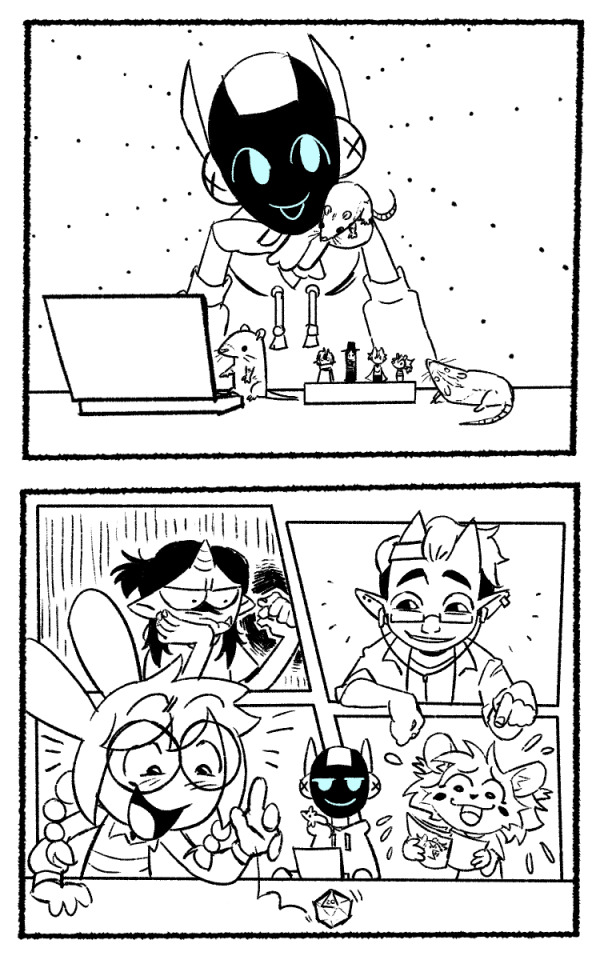
Glitch (@eternalglitch), our game master, weaves all our loose threads into one coherent story.
One fun rule we’ve incorporated into this campaign: players CANNOT share their character backstories with each other outside of gameplay.
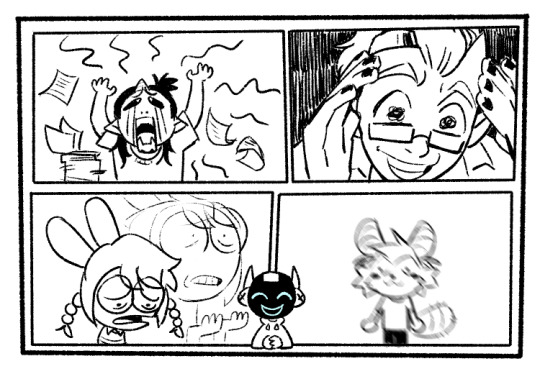
It gives more mystery fun! It’s also driving us insane. Pray for us.
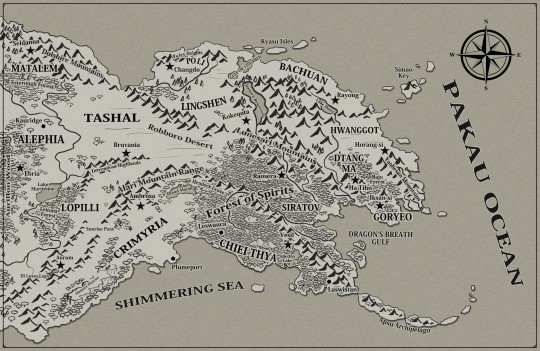
(Map created by @dovelydraws, summary also written by Dove)
A lot has gone into the cultures and politics of each of the countries our characters come from. Enough so that it doesn't make sense to get into all of it on an introductory post! But perhaps later in a reblog.
THE STORY SO FAR…
As of the writing of this post, we have now played 5 sessions of the campaign.
Our party all met each other in the small seaside town of Plumeport, Crimyria. We were all brought together in pursuit of the same thing: a legendary man-eating boar, said to hold the power of immortality.
It is believed that consuming the flesh of this boar would grant eternal life, and even just a bit of its fur or blood can extend a person's life, for a time. The King of Crimyria himself has offered whoever can take down this boar a large sum of wealth and a small offering of its blood for personal consumption. He wants the job to be done in time for the Crimyrian Festival of Flight, in a couple months time.
The bounty on the boar's head has drawn adventurers from all over the continent, but none so far have been able to take it down. Many have lost their lives. While each of our party members have their own reasons for wanting to take on this job, Kwan has a very personal stake in their success.
He has, reluctantly, revealed that he once knew the boar before it obtained the power it has today. He has reason to believe it has swallowed something once known as a centurion pearl: a powerful artifact that caused the fall of a once great kingdom, and threw the continent into tumultuous conflict. Kwan is adamant that this power should not be handed over to any king. Once it is killed, they want to extract the pearl from its body to make sure it can never fall into the wrong hands.
So far, Kwan has only revealed this to Revun. Polites, meanwhile, works directly under the king and wants to succeed on this mission to make him proud. Ferra seems to only be interested in the money and adventure. Revun has also said they were in this for the money, but vaguely admitted to Kwan that they also had their own personal reasons to go after the boar, and if he truly believes its power is too dangerous, they will follow his lead.
Once faced with the boar, however, the party was unprepared and outmatched. It was massive, its eyes as large as their heads, emanating a golden glow. It moved unlike a normal animal, and seemingly bore a higher level of intelligence than it should.
After a deceptively strong start, Polites went down in battle, and they were all forced to run to ensure everyone's survival. Before retreating though, Kwan shot the boar with a strange arrow, claiming they would be able to track it again later.
The party camped outside of the marsh, unable to sleep while waiting for Polites to wake up. They discussed next steps- going back to the city to regroup, get proper healing, and perhaps find a sponsor to help them in their next try. They still have a few weeks to get things figured out.
And that's all, so far! We're all pretty stoked and making tons of art and written works, so keep a look out, we might publish a zine when the sessions start wrapping up. Bye-bye, for now!
273 notes
·
View notes
Text
The Conduit

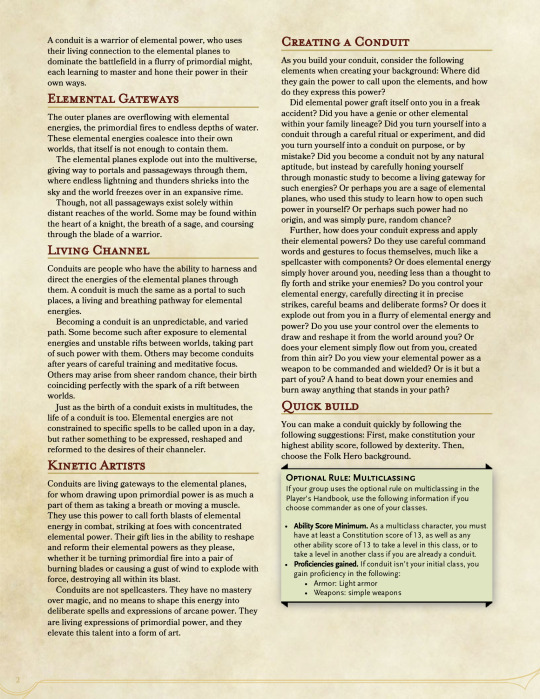
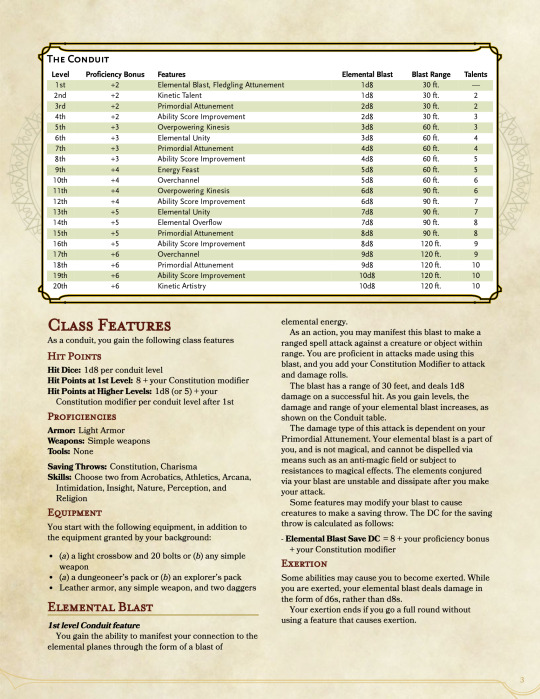
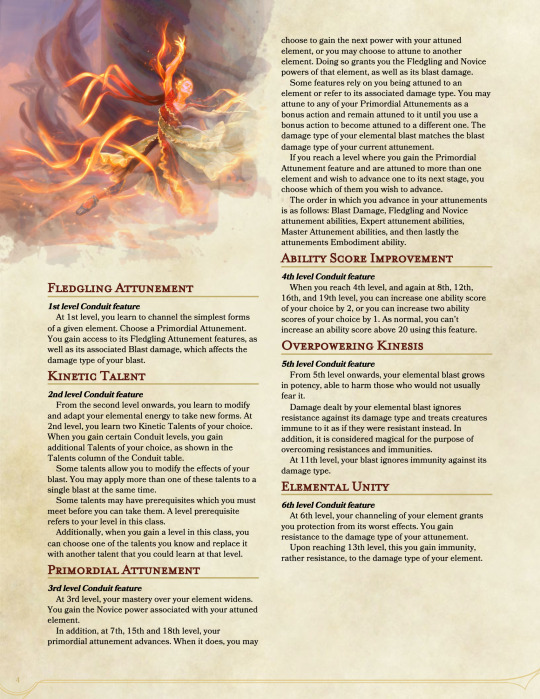

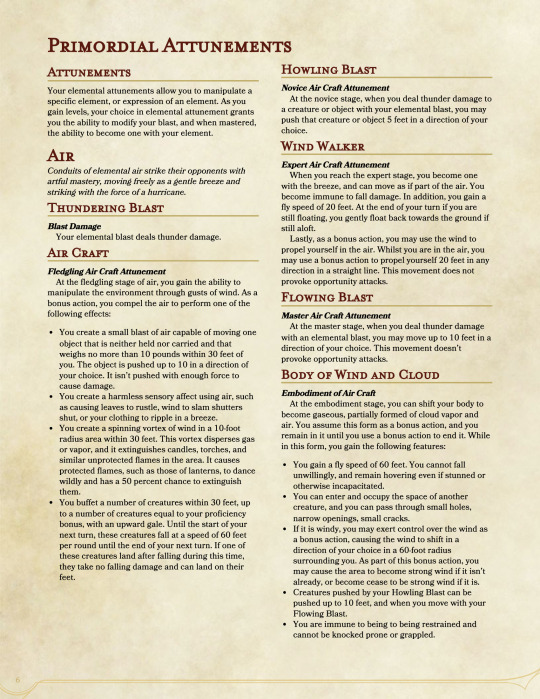



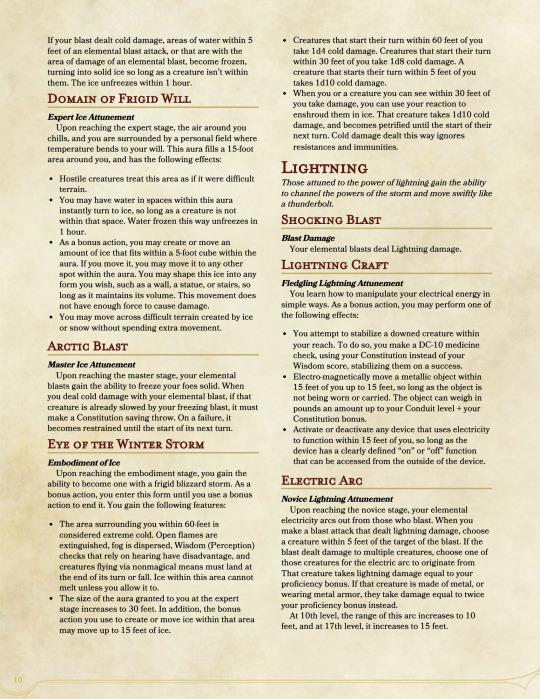
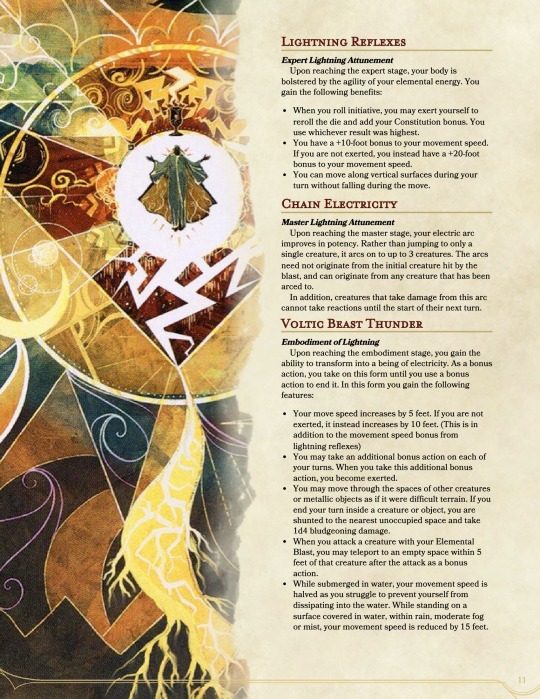
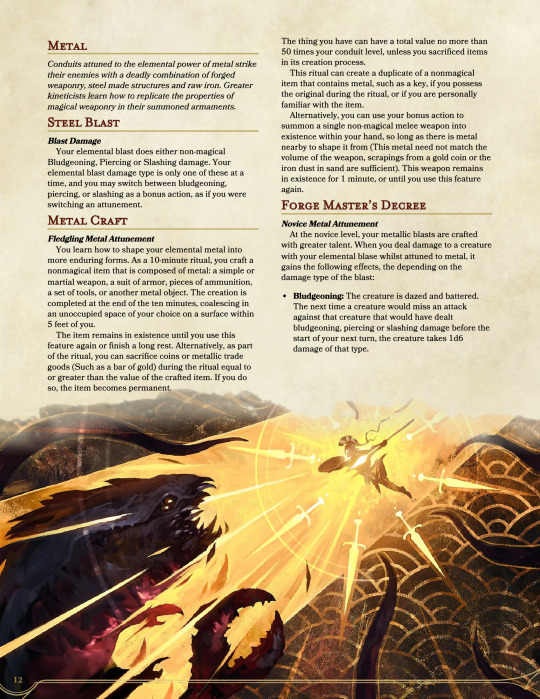
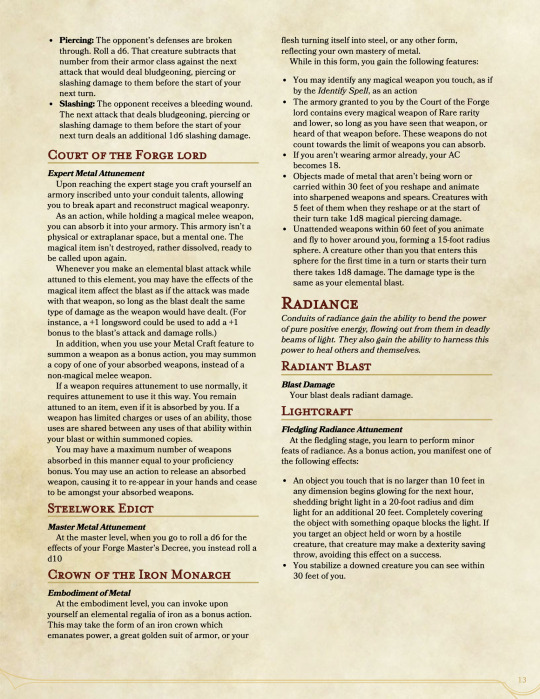

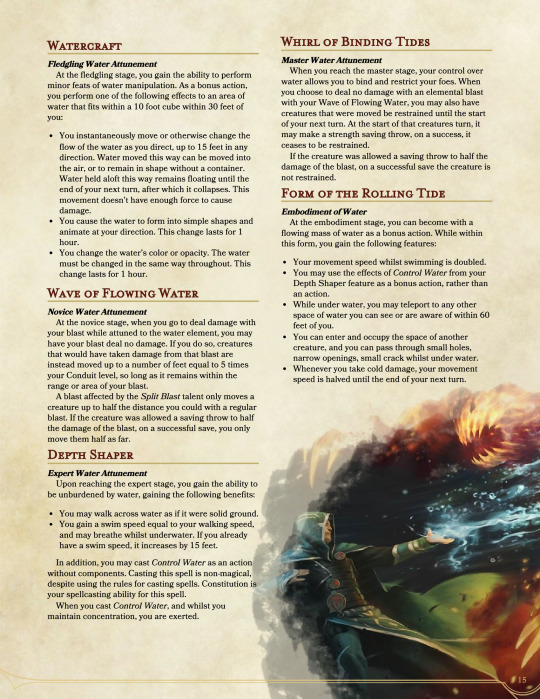
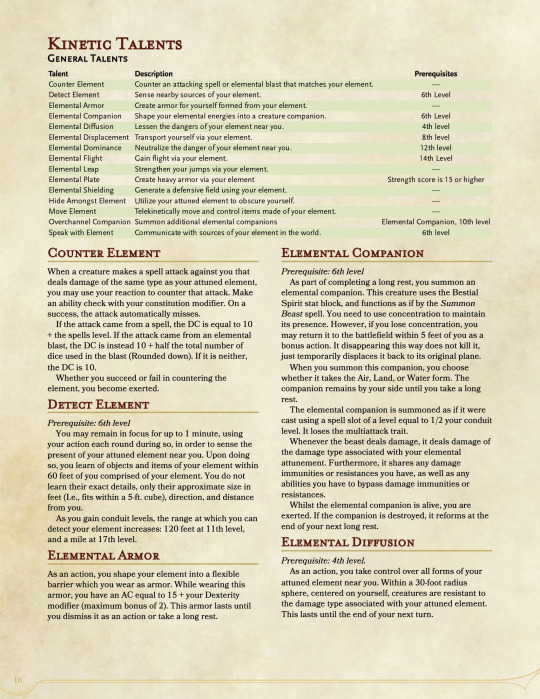

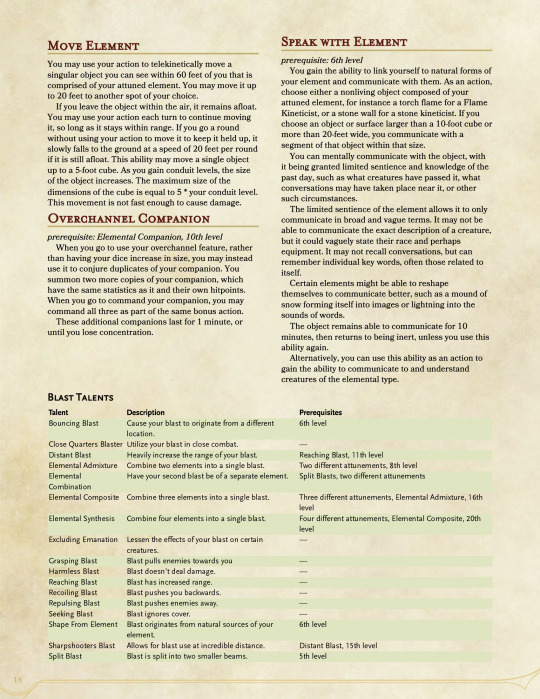
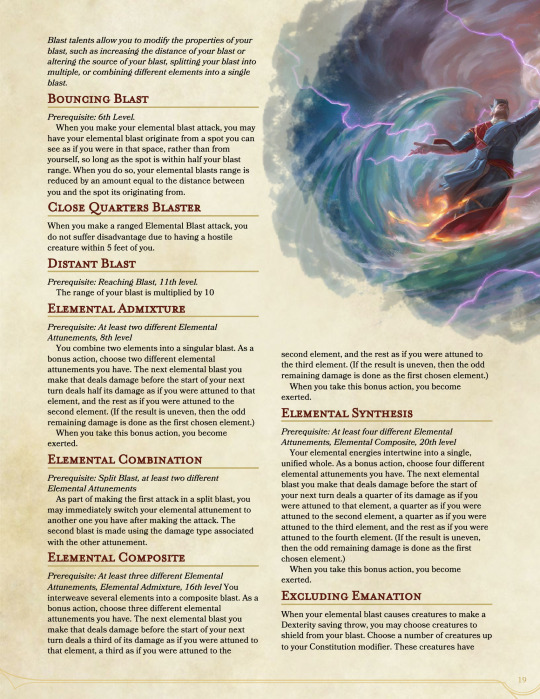
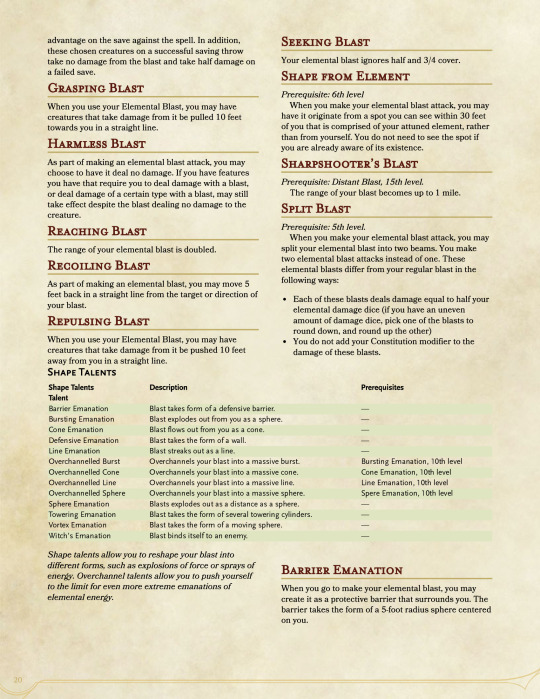


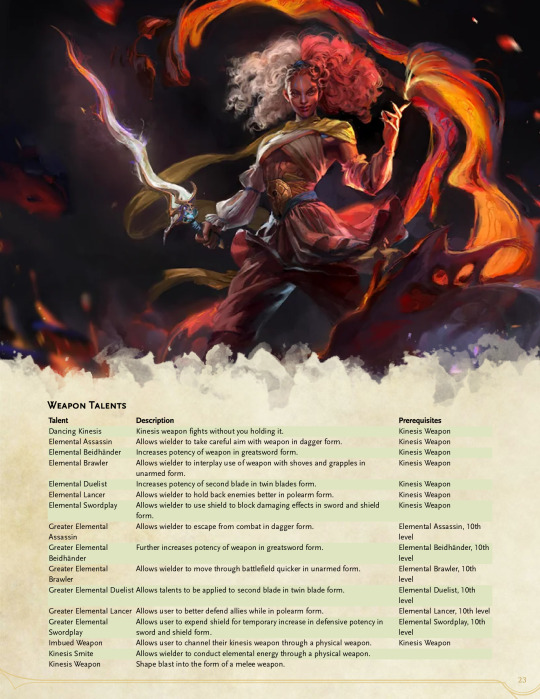

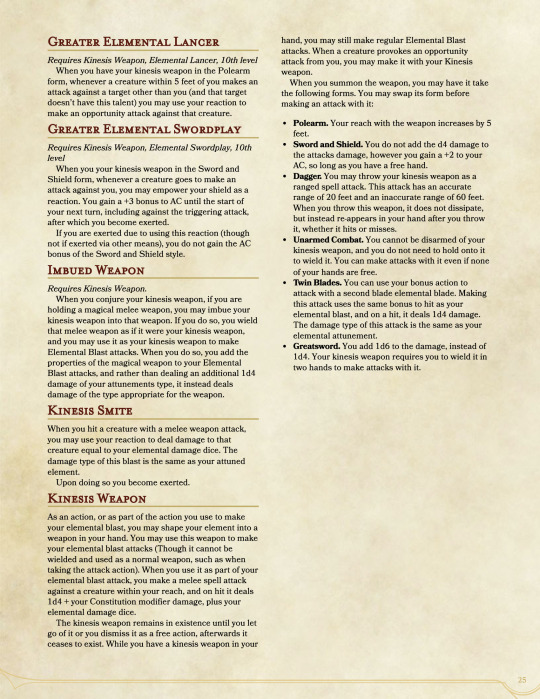

So heres the conduit! I'm very happy with how this turned out.
The conduit as a class is best described as a "Con Based Martial with spellcaster aesthetics", since, mechanically, it fills a martial role, being a class that doesnt use resources, with a primary party focus on dealing damage, while flavor wise, it goes around slinging blasts of energy at people.
This class mechanically is very much based on the warlock of 3rd edition, with flavour and some mechanical inspiration from the Kineticist of Pathfinder 2e.
The two core design elements that I tried to stick to with making this were 1. Being resourceless and 2. Customizability.
For the first point, none of the class features are limited in uses per day. No feature adds an additional resource for the player to track, nor uses spell slots nor etc. The closest it comes to a resource is its Exertion mechanic, where certain things tire out your conduit character. Though, this serves less as a resource, and more as a temporary debuff, reducing your damage output whilst its in effect, before being easily removed.
The second point is customizability. The first element of this is subclasses. Of course, theres the variety of subclasses to pick from, but notably, is that unlike other classes, you aren't bound to picking just one subclass. From 7th level onwards, whenever you reach your subclass feature level, you can choose to continue advancing in your subclass, or you can take the initial features of a different subclass. This means while you can do a more traditional route of going "I'm the lightning guy, I'm taking lightning every level", you can also do an avatar style "Master of 4 elements" and have 4 different subclasses by level 20. Mix and match them as you like, be the "Fire and Lightning" person, be the "I control water mostly, but also a little bit of ice", combine your elements and so forth.
The next part of customizability is in talents. Talents are very much your classic invocation style feature, of which there are... like. 60 of them at this point. But! Theres a lot of variety in what they do. While you have your choices of ones that give additional powers, like flight or teleportation or whatnot, a large bulk of them are dedicated to one thing: Reshaping your elemental blast. Go out there as a fire guy and blast people with fire, then turn around and literally explode everything around you in flames, then focus your blast into a roaring line of fire that pushes everything within it towards you, and then rush the last man standing with a spear made of literal fire.
The talents are designed around not just being able to reshape and modify your blast in a bunch of different ways, but you can combine them together and do cool stuff.
Because at its core, I wanted to design this class to fill a very specific style of fantasy, and thats of the type of magic you see in some settings where its just "I control this one element", and then from that the mage turns that into a billion different things.
A fire wizard will say "I can cast fire bolt, fire ball, and scorching ray". A fire conduit instead just has an elemental blast, but they can turn that elemental blast into a bolt that is hurled at one person, or have it explode into a ball of flame, or split it into multiple beams.
Its very much a creativity first subclass, and thats whats behind its capstone! The capstone is all of this at its epitomy, the ability to freely reshape your elemental power (By freely, temporarily learning talents) into whatever form you imagine.
Hell, customizability is built even into the very core of its flavour
Yeah <3
I hope you guys enjoyed reading this class as much as I enjoyed writing it and as much as I enjoy talking about it <3
148 notes
·
View notes
Text
"how do you play a warlock in Pathfinder 2e" - fortunately, and unfortunately, the answer is perhaps fivefold I'd argue, depending on WHAT precisely about the warlock you find appealing: witch, thaumaturge, magus, psychic or oracle.
The PF2E witch is a full spellcaster using intelligence - but they rely on a patron who gives them their spells via a special familiar. Definitely Pact of the Chain warlock vibes. However, way more powerful spellcasting then a 5e warlock, more equivalent to a wizard.
The thaumaturge has strong occult vibes, focused on "esoterica" - magical scraps and relics that empower special abilities. No patron, technically not spellcasting, but a Charisma-based occult magic user that looks sick as hell. Does seem a bit Hexbladey though, given armor and weapon proficiencies and capacity for melee combat.
The magus similarly is a strong melee combatant, with limited spellcasting much more akin to how the warlock pact slots work in 5e (though Intelligence based). They can use spells to empower their weapon strikes, and they can only cast at their highest two spell levels available (though unlike the warlock, these levels go all the way to 9)
If the thing you like most about the warlock is being able to build a mass murderer around a cantrip, the psychic might be right for you. One of their cool base class features is additional psychic-only cantrips, which you can then "amp" for more power and utility.
The oracle, like the thaumaturge, shares more flavor than mechanics with the warlock, and is probably the weakest case for equivalency in this post. They're charisma casters with divine spells, but unlike clerics their power isn't from a god, but rather a "mystery". One of their key features is a curse, which as it's strengthened provides both power and drawbacks. The curse mechanics feel very eldritch.
ANYWAY at first glance I was like "wtf no warlock, that seems like a missed opportunity" but no, Paizo was like "how do you like your warlock?" and served you up a buffet.
Visit Archives of Nethys if you're interested!
#ttrpg#pathfinder witch#pathfinder magus#pathfinder thaumaturge#pathfinder psychic#pathfinder oracle#pathfinder#pathfinder 2e#warlock dnd#dnd 5e
290 notes
·
View notes
Text
Skelm, Street
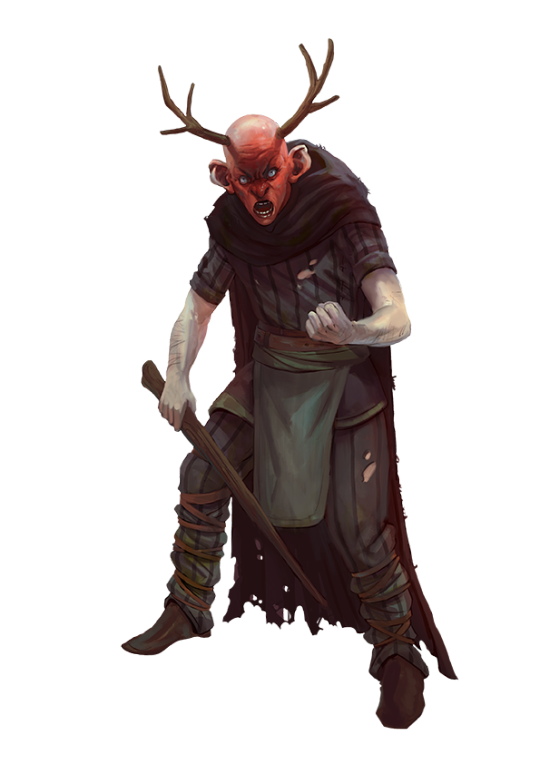
Image © Paizo Publishing. Accessed at Archives of Nethys here
[I love the skelms. They might be my favorite Pathfinder monster new to 2e. I've seen the idea of a male equivalent to hags discussed before. Someone on rpg.net, maybe it was @crinosg or @prokopetz, gave their take the name "coots" and used the Old Man of the Mountain from a Betty Boop cartoon as their model. Paizo's brilliant idea was tying their male hag analogue to ideas of toxic masculinity and entitlement. Since I'm someone who loves to use monsters as tools of social commentary, I was basically their target audience here.]
Skelm, Street
CR 3 LE Monstrous Humanoid
If not for his unnaturally red face and the rack of antlers growing from his brow, this could be an ordinary human. He wears leather armor and carries a cane.
Skelms are creatures of rage and spite, created spontaneously from evil humanoids overwhelmed by anger. All skelms are male, and some sages posit that they are some sort of metaphysical counterpart to hags. Unlike the prolonged ritual to make a hag, a skelm can arise from a totally normal person in a matter of hours—skelms often hold court over potential recruits and transform them through brutal, humiliating hazing. After transformation, a skelm will often return to their previous life, hiding their inhuman features through magical disguises and changing their pursuits to cruelty and exploitation full time.
All skelms have antlers, which are a source of combined pride and shame. Skelms with smaller racks will belittle those with larger ones, although they will claim other reasons for this scorn if pressed. Even more distinctively, skelms deny that they have antlers when dealing with non-skelms, regardless of evidence or argument.
Street skelms are the weakest of the skelms. In their mortal guise, street skelms exploit the respect most people give to the elderly and the wealthy, and they usually appear as one or both of these in order to recruit a mob. Street skelms have little in the way of magical talents, but they are skilled at finding scapegoats to blame for community ills and sic their followers after. Street skelms have even more of a chip on their shoulder than other skelms do, and their egos are especially delicate. Their combat tactics, whether they are in their monstrous forms or not, tend to revolve around doing an immense amount of damage to a single target at a time, preferably a weak or vulnerable one, and then crowing about it for a few rounds before resuming their assault.
Street Skelm CR 3
XP 800
LE Medium monstrous humanoid
Init +2; Senses Perception +7, scent
Defense
AC 17, touch 13, flat-footed 14(+2 Dex, +1 dodge, +2 armor, +2 natural)
hp 25 (3d10+9)
Fort +5, Ref +6, Will +5; -2 vs. emotion effects
DR 3/cold iron
Offense
Speed 30 ft.
Melee gore +7 (1d6+6 plus trip) or improvised club +7 (1d6+4), gore +2 (1d6+2 plus trip)
Ranged rock +5 (1d4+4)
Special Attacks belittling rant,improvisational brawler, punishing strike
Statistics
Str 18, Dex 15, Con 17, Int 16, Wis 13, Cha 18
Base Atk +3; CMB +7; CMD 19
Feats Catch Off Guard (B), Combat Reflexes, Dodge, Throw Anything (B)
Skills Bluff +7,Disguise +7, Intimidate +13, Knowledge (local) +6, Perception +7, Sense Motive +4, Stealth +8; Racial Modifiers +4 Intimidate
Languages Aklo, Common
SQ change shape (Small or Medium male humanoid, alter self),skelm traits
Ecology
Environment urban
Organization solitary or gang (1 plus 2-24 humanoids)
Treasure standard
Special Abilities
Belittling Rant (Su) As a standard action, a street skelm can give a rant that affects all creatures that can hear and understand it within 30 feet. A DC 15 Will save negates the effect. A creature affected by a street skelm is shaken for 1 minute. Anyone shaken in this way takes an additional -2 to damage rolls against the skelm, but gains a +2 morale bonus to damage rolls against other targets. The save DC is Charisma based.
Improvisational Brawler (Ex) A street skelm gains Catch Off Guard and Throw Anything as bonus feats. A street skelm treats all improvised ranged weapons as having a 20 foot range increment.
Punishing Blow (Ex) As a standard action, a street skelm can exert himself to make a single powerful attack. When he does, he adds an additional damage die of the same type to the attack, and can make a CMB check as a free action without provoking an attack of opportunity to push the creature hit 5 feet. After making this attack, the street skelm is treated as being flat footed until the beginning of its next turn.
Skelm Traits (Ex) All skelms gain a +4 racial bonus to Intimidate checks, but a -2 penalty to all saving throws against emotion effects.
#skelm#street skelm#monstrous humanoid#pathfinder 1e#pathfinder 2e#hag#social commentary#toxic masculinity
119 notes
·
View notes
Note
So we all hate DnD, but I am kinda curious what are the actually bad ttrpgs?
I know that 3,5e and pf got bloated even more than 5e did, FATAL is a meme, but what else?
I think Chronicles of Darkness tell you the system's gonna be a sleek, streamlined narrative system and then immediately bukakke's pointless fiddly complexity all over everything, to an extent that I never see most STs actually use half the subsystems (does anybody actually like the Doors mechanic?) but also you can utterly break the game if you combine the right merits and powers in a way that I really hope isn't intentional. WoD games all have slightly clunky, lame mechanics but at least in OWoD the mechanics take an extremely simulationist approach of simply modeling the fiction, balance be damned; CoD throws out the simulationism in favour of abstraction and narrativism, but perversely only makes the mechanics more complex, and deploys more weird dice tricks so eyeballing probabilities gets much harder. Everything is fiddly, everything has specific exceptions, and everything good is gated behind weird prerequisites and builds as if the devs thought they were making pathfinder. If you're some sort of weirdo who actually prefers the CoD settings, run them using OWoD mechanics for the love of god.
Shadowrun 6e's character generation is so complex that people have created third party apps that are basically mandatory in order to wrangle it into shape. It's notoriously complex in play with basically every action requiring multiple steps of calculation, to the extent that 'you need to do calculus if you set off a grenade next to a wall' is a meme; when I played we simply never used grenades because we were all to scared of trying to make sense of the mechanics. However, in play a slightly minmaxed mage can make every other party member obsolete by simply summoning an extremely powerful spirit to solve every task. I hated every minute of it.
Pokemon Tabletop Adventures uses d20-based mechanics for trainers, where you roll a d20 vs armour class to hit, and then roll some damage. It also recreates the mechanics of the pokemon video games largely verbatim. Its expected that trainers and pokemon can and will interact despite using totally different systems, and trainers can even learn pokemon moves. Some classes are good at things like 'capturing and training pokemons' while others are good at 'fighting pokemons themselves with martial arts' or 'winning contests' or 'being a film noir detective', but you only get XP or mechanical support for the first ones. Some classes get abilities like 'perfect mind-control, no save' while others get abilities like 'you're better at growing berries'. You are expected to calculate the stats of every pokemon individually, from scratch, for every encounter. Encounters typically feature 5-10 wild pokemons often of multiple species and levels, alongside 3-5 player characters and up to six pokemons per PC. Its a fractal spreadsheet nightmare. Unlike shadowrun, the app to make this insanity playable doesn't exist. Good god. Send help.
On the other end of the spectrum from stupid fiddly crunch, Ten Candles is responsible for the single most miserable ttrpg experience of my life. It claims to be a narrative game which gives players the ability to define the fiction as they go, but fails at this because the GM has secret knowledge that other players aren't privy to, meaning that it invites players to be creatively vulnerable when they have narrative authority, with a chance that they might get their contributions unilaterally overruled due to information they had no way of knowing. Since the game ends with everybody dying automatically, the game inherently leans on the GM to railroad in what's meant to be a colaberative narrative experience. And finally, on a purely practical level, the clever conciet of playing by candlelight and extinguishing candles as the game progresses means that by half-way in you can't read your fucking character sheets or dice, which is less spooky and more irritating. God I hate ten candles.
45 notes
·
View notes
Text
…I want to make a new Durge. A bard ‘conducting a beautiful symphony of murder’. Sounds like fun.
#BG3#my durge#BG3 encourages my wild PC making even worse than Pathfinder#because I can actually go through with making a new Durge/Tav and play right away#no one can stop me#unlike Pathfinder where I need other people and a campaign to actually play any character I think up#I am going to replay this damn game so many times lmao#this will probably either be my Gales romance or my Minthara run
1 note
·
View note
Text
I think I've talked about this before, but Rakshasa Immortals are one of the most amusing but also interesting categories of archfiends in Pathfinder. Many fiends achieve the status of archfiend by taking it through strength, guile, or alliance, but Immortals reach their status through personal achievement.
Rakshasa--at least in 1st Edition lore, which I prefer to their 2e lore--are one of very few Outsiders who grow, age, and die, but unlike most mortals, they do not go to the Boneyard. Instead, they forcibly reincarnate themselves into new bodies. If a Rakshasa lived well and died peacefully, it can reincarnate into a form as great or greater than its previous one... but if they died in battle or having achieved nothing in their life, they are forced into lesser and lesser bodies with fewer and fewer of their past memories, until eventually their spirit is annihilated.
Immortals are just that: Rakshasa that have broken away from the cycle of reincarnation and, somehow, become truly immortal. For the majority of them this involves undertaking a task of incredible personal significance, one which often takes multiple lifetimes to complete, the reward for achieving this impossible personal goal being the freedom to glut on life's pleasures uninterrupted for the rest of their days. It's a twisted parody of the promise of eternal paradise, which certainly suits the twisted fiends.
I bring this up because many of the methods of immortality are funny. Vibhishah sealed the spirit of a great shaman into one of his whiskers, and when it inevitably fell from his face, he spent several hundred lifetimes searching for it again, achieving immortality when he found it. Dradjit sustains her immortality by wearing the teeth of another Immortal she killed by herself as a necklace. My favorite, however, is Zabha, whose quest for immortality saw him blaspheming against every non-Evil deity in existence, while also dancing on the graves of 10,000 different saints. I just appreciate the effort, if nothing else, spending weeks upon weeks in libraries, laboriously researching every god he could no matter how obscure they were in order to concoct the perfect way to blaspheme against them. It's implied that his quest wasn't just the gods of Golarion, either! Then comes the challenge of finding, breaking into, and then dancing on the graves of 10,000 different individual saints.
One almost has to respect the energy Zabha displays. The Ultimate Hater, the enemy of all that is Good... or even just Neutral.
96 notes
·
View notes
Note
Hey just wanted to say that the work you do is really inspiring. I think the TTRPG community has needed an urban fantasy noir sort of thing for a little while and I really like the direction you're taking it in. Looking forward to stuff in the future!!
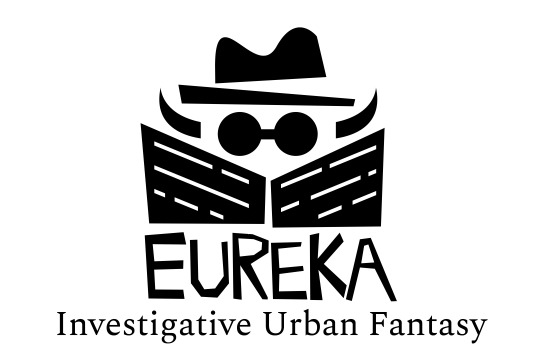
Thank you! Basically all our projects come from a place of need, each one being something that we wanted to play ourselves, but either it just didn’t exist, or the people who did do it didn’t do it to our satisfaction.
Since it’s our blog we can toot our own horn a bit, and yeah, the TTRPG community did need Eureka. The whole idea originally came out of our dissatisfaction with investigation and mystery-solving gameplay in most of the other more well-known TTRPGs that attempt to tackle this genre, such as Call of Cthulhu, Delta Green, and Gumshoe. They either make it too easy for bad dice rolls to get the party hopelessly stuck by relying too heavily of the PC’s skills, or make things difficult on the player by not giving the PC’s skills quite enough input, which can make efficient mystery solving very difficult across sessions with a whole week or more of real time in between them. (And it’s barely even worth mentioning that the most popular TTRPGs such as D&D5e and Pathfinder just plain cannot do investigative gameplay to any respectable degree at all.)
Eureka: Investigative Urban Fantasy’s Investigation Point and Eureka! Point system, whereby each skill check to investigate something fills a bar on the character sheet until the investigator gets a “Eureka!”, which can be spent to retroactively gain information from an investigation skill check that they previously failed, as well as many other specific rules that are too nuanced to go into here but that you can read about in the free version of the rulebook, are part of our answer to that. As you are putting the pieces together in your own mind, so is your character, and this system acts as a failsafe, but not a crutch, to prevent a single bad dice roll from leaving the party totally twisting in the wind.
And I personally have always been really autistic about folklore, which is where Eureka’s unique approach to playable monsters comes in. No RPG had ever really done certain monsters to my satisfaction, particularly vampires. Folkloric vampires have a great deal of quirks and weaknesses that usually get cut from any sort of vampire media because they’re too “silly,” but I disagree. I want them all, and so when a monster is playable in Eureka, it’s its own unique experience, unlike playing anything else in any other game or even within Eureka. (I am very, very proud to say that a number of V:TM veterans have said that Eureka does vampires much better than V:TM itself.)
Not every playable monster in Eureka is 100% strictly folkloric, which was a bit of a struggle for me, but ultimately the small exceptions that were made make the RPG better, so I can’t complain, especially because we managed to weave some pretty cool themes into all of them, which I will touch on more when I finally get finished writing that big huge post about, well, Eureka’s themes.
Eureka: Investigative Urban Fantasy is kickstarting from right now until May 10th! Back it while you still can!
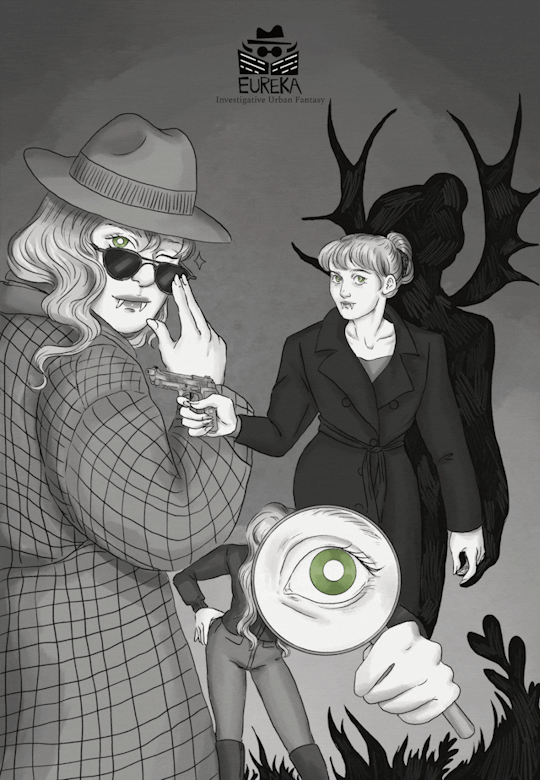

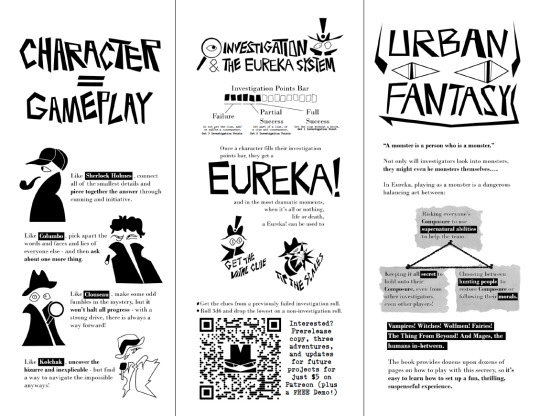
youtube
If you want to try before you buy, you can download a free demo of the prerelease version from our website or our itch.io page!
If you’re interested in a more updated and improved version of Eureka: Investigative Urban Fantasy than the free demo you got from our website, subscribe to our Patreon where we frequently roll our new updates for the prerelease version!
You can also support us on Ko-fi, or by checking out our merchandise!
Join our TTRPG Book Club At the time of writng this, Eureka: Investigative Urban Fantasy is the current game being played in the book club, and anyone who wants to participate in discussion, but can’t afford to make a contribution, will be given the most updated prerelease version for free! Plus it’s just a great place to discuss and play new TTRPGs you might not be able to otherwise!
We hope to see you there, and that you will help our dreams come true and launch our careers as indie TTRPG developers with a bang by getting us to our base goal and blowing those stretch goals out of the water, and fight back against WotC's monopoly on the entire hobby. Wish us luck.

#eureka: investigative urban fantasy#ttrpg#rpg#roleplaying#eureka#tabletop#monsters#vampire#vampiric#vampire art#vampirism#vampire core#vampcore#monster girl#monster design#monster art#werewolf#creature design#call of cthulhu#motw ttrpg#motw#monster of the week#ttrpg character#ttrpg community#ttrpg tumblr#ttrpg art#indie ttrpg#dungeons and dragons#delta green#gumshoe
75 notes
·
View notes